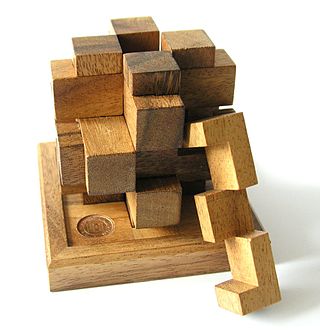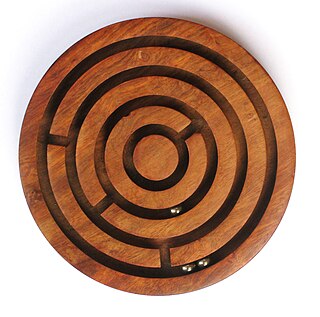Related Research Articles

The Rubik's Cube is a 3D combination puzzle invented in 1974 by Hungarian sculptor and professor of architecture Ernő Rubik. Originally called the Magic Cube, the puzzle was licensed by Rubik to be sold by Pentangle Puzzles in the UK in 1978, and then by Ideal Toy Corp in 1980 via businessman Tibor Laczi and Seven Towns founder Tom Kremer. The cube was released internationally in 1980 and became one of the most recognized icons in popular culture. It won the 1980 German Game of the Year special award for Best Puzzle. As of January 2024, around 500 million cubes had been sold worldwide, making it the world's bestselling puzzle game and bestselling toy. The Rubik's Cube was inducted into the US National Toy Hall of Fame in 2014.
Recreational mathematics is mathematics carried out for recreation (entertainment) rather than as a strictly research- and application-based professional activity or as a part of a student's formal education. Although it is not necessarily limited to being an endeavor for amateurs, many topics in this field require no knowledge of advanced mathematics. Recreational mathematics involves mathematical puzzles and games, often appealing to children and untrained adults and inspiring their further study of the subject.

Samuel Loyd was an American chess player, chess composer, puzzle author, and recreational mathematician. Loyd was born in Philadelphia but raised in New York City.

The tangram is a dissection puzzle consisting of seven flat polygons, called tans, which are put together to form shapes. The objective is to replicate a pattern generally found in a puzzle book using all seven pieces without overlap. Alternatively the tans can be used to create original minimalist designs that are either appreciated for their inherent aesthetic merits or as the basis for challenging others to replicate its outline. It is reputed to have been invented in China sometime around the late 18th century and then carried over to America and Europe by trading ships shortly after. It became very popular in Europe for a time, and then again during World War I. It is one of the most widely recognized dissection puzzles in the world and has been used for various purposes including amusement, art, and education.
A puzzle is a game, problem, or toy that tests a person's ingenuity or knowledge. In a puzzle, the solver is expected to put pieces together in a logical way, in order to achieve the correct solution of the puzzle. There are different genres of puzzles, such as crossword puzzles, word-search puzzles, number puzzles, relational puzzles, and logic puzzles. The academic study of puzzles is called enigmatology.

A mechanical puzzle is a puzzle presented as a set of mechanically interlinked pieces in which the solution is to manipulate the whole object or parts of it. While puzzles of this type have been in use by humanity as early as the 3rd century BC, one of the most well-known mechanical puzzles of modern day is the Rubik's Cube, invented by the Hungarian architect Ernő Rubik in 1974. The puzzles are typically designed for a single player, where the goal is for the player to discover the principle of the object, rather than accidentally coming up with the right solution through trial and error. With this in mind, they are often used as an intelligence test or in problem solving training.

The 15 puzzle is a sliding puzzle. It has 15 square tiles numbered 1 to 15 in a frame that is 4 tile positions high and 4 tile positions wide, with one unoccupied position. Tiles in the same row or column of the open position can be moved by sliding them horizontally or vertically, respectively. The goal of the puzzle is to place the tiles in numerical order.

David Breyer Singmaster was an American-British mathematician who was emeritus professor of mathematics at London South Bank University, England. He had a huge personal collection of mechanical puzzles and books of brain teasers. He was most famous for being an early adopter and enthusiastic promoter of the Rubik's Cube. His Notes on Rubik's "Magic Cube" which he began compiling in 1979 provided the first mathematical analysis of the Cube as well as providing one of the first published solutions. The book contained his cube notation which allowed the recording of Rubik's Cube moves, and which quickly became the standard.

Nobuyuki Yoshigahara was perhaps Japan's most celebrated inventor, collector, solver, and communicator of puzzles.

A sliding puzzle, sliding block puzzle, or sliding tile puzzle is a combination puzzle that challenges a player to slide pieces along certain routes to establish a certain end-configuration. The pieces to be moved may consist of simple shapes, or they may be imprinted with colours, patterns, sections of a larger picture, numbers, or letters.

Uwe Mèffert was a German puzzle designer and inventor. He manufactured and sold mechanical puzzles in the style of Rubik's Cube since the Cube craze of the 1980s. His first design was the Pyraminx – which he had developed before the original Rubik's Cube was invented. He created his own puzzle company and helped bring to market the Megaminx, Skewb, Skewb Diamond and many other puzzles.

The T puzzle is a tiling puzzle consisting of four polygonal shapes which can be put together to form a capital T. The four pieces are usually one isosceles right triangle, two right trapezoids and an irregular shaped pentagon.
Nicolas Hammond is a British Rubik's Cube expert and businessman. He has lived in the US since 1986. He made the world's first Internet banking transaction.

A combination puzzle, also known as a sequential move puzzle, is a puzzle which consists of a set of pieces which can be manipulated into different combinations by a group of operations. Many such puzzles are mechanical puzzles of polyhedral shape, consisting of multiple layers of pieces along each axis which can rotate independently of each other. Collectively known as twisty puzzles, the archetype of this kind of puzzle is the Rubik's Cube. Each rotating side is usually marked with different colours, intended to be scrambled, then solved by a sequence of moves that sort the facets by colour. Generally, combination puzzles also include mathematically defined examples that have not been, or are impossible to, physically construct.
Derrick Corson Niederman is an author, mathematician, game designer, and national squash champion. His most recent game, 36 Cube, has been described by Reuters as "a wolf in sheep's clothing" because its simple design belies the sophisticated mathematical intuition required for the solution. He received a B.A. in mathematics from Yale and a Ph.D. in mathematics from MIT. Dr. Niederman is a math professor at the College of Charleston.

Ball-in-a-maze puzzles are dexterity puzzles which involve manipulating either a maze or one or several balls so that the ball or balls are maneuvered towards a goal. Toys like this have been popular since Pigs in Clover was invented by Charles Martin Crandall and then patented on September 10, 1889. The game was a craze in the United States from mid-February to May 1889, at 8 000 puzzles being produced daily according to The Waverly Free Press. It was played at home, on buses, in the street, parks, and even by US politicians. Sam Loyd falsely claimed to have invented it in an interview in 1891.
Stewart Coffin is an American puzzle maker. According to Ars Technica, he is considered to be one of the "best designers of polyhedral interlocking puzzles in the world."
Panagiotis Verdes is a Greek inventor and is known for being the first person to mass produce 6x6x6 puzzles and 7x7x7 twisty puzzles. He is also known for founding the company V-Cube. He has also worked on new designs of every Twisty Puzzle from 2x2x2 to 11x11x11.

Tony Fisher is a British puzzle designer who specialises in creating custom rotational puzzles. He is acknowledged by cubing enthusiasts as a pioneer in the creation of new puzzle designs and new manufacturing techniques. In 2017 the Guinness Book of World Records acknowledged Fisher as the creator of the world's largest Rubik's cube.
References
- ↑ Association Awards: Sam Loyd Award Association for Games & Puzzles International
- ↑ Wertheim, Margaret (July 25, 2006). "Celebrating Puzzles, in 18,446,744,073,709,551,616 Moves (or So)". New York Times. Retrieved 2007-10-23.